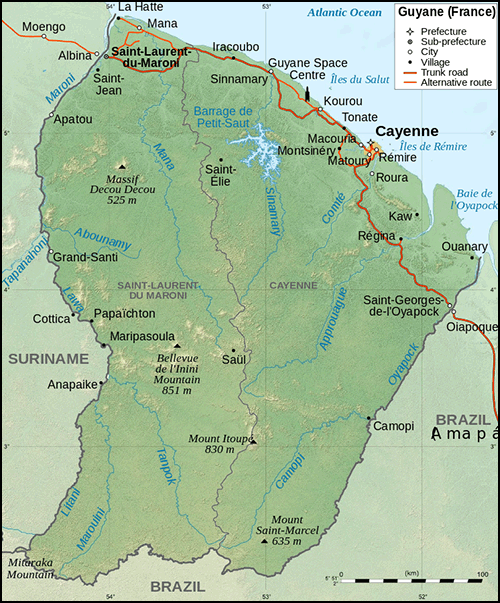French Guiana
 Aglow Status:
Aglow Status:
No Aglow presence
Capital: Cayenne
Pray:
- We are praying for Aglow to be affiliated in every nation in the world. We are very close to reaching that goal. Let’s continue to move forward together, an army in the Spirit, to see Every nation touched, every heart changed.
- Pray that an Aglow Prayer Group will be established in the capital city.
- Pray for many to arise in Aglow International in French Guiana.
Proclaim:
- Arise, shine; for your light has come! And the glory of the LORD is risen upon you. For behold, the darkness shall cover the earth, and deep darkness the people; but the LORD will arise over you, and His glory will be seen upon you. Isaiah 60:1, 2 (NKJV)
- Lift up your heads, O you gates! Lift up, you everlasting doors! And the King of glory shall come in. Who is this King of glory? The Lord of hosts, He is the King of glory. Selah Psalm 24:9-10 (NKJV)
Interesting Facts About French Guiana
Background: French Guiana was originally inhabited by indigenous people. The French tried to create a colony there in the 18th century in conjunction with its settlement of some other Caribbean islands. Bill Marshall wrote:
The first French effort to colonize Guiana, in 1763, failed utterly when tropical diseases and climate killed all but 2,000 of the initial 12,000 settlers. During its existence, France transported approximately 56,000 prisoners to Devil’s Island. Fewer than 10 percent survived their sentence.
Its infamous Île du Diable (Devil’s Island) was the site of a small prison facility, part of a larger penal system by the same name, which consisted of prisons on three islands and three larger prisons on the mainland, and which was operated from 1852 to 1953. In addition, in the late nineteenth century, France began requiring forced residencies by prisoners who survived their hard labor. A Portuguese-British naval squadron took French Guiana for the Portuguese Empire in 1809. It was returned to France with the signing of the Treaty of Paris in 1814. Though the region was handed back to France, a Portuguese presence remained until 1817.
A border dispute with Brazil arose in the late 19th century over a vast area of jungle leading to the short-lived pro-French independent state of Counani in the disputed territory. There was some fighting between settlers. The dispute was resolved largely in favor of Brazil by the arbitration of the Swiss government.
The territory of Inini consisted of most of the interior of French Guiana when it was created in 1930. It was abolished in 1946, when French Guiana as a whole became an overseas department of France. During the 1970s, following the French withdrawal from Vietnam in the 1950s, France helped resettle Hmong refugees from Laos to French Guiana.
In 1964, French president Charles de Gaulle decided to construct a space-travel base in French Guiana. It was intended to replace the Sahara base in Algeria and stimulate economic growth in French Guiana. The department was considered particularly suitable for the purpose because it is near the equator and has extensive access to the ocean as a buffer zone. The Guiana Space Centre, located a short distance along the coast from Kourou, has grown considerably since the initial launches of the “Véronique” rockets. It is now part of the European space industry and has had commercial success with such launches as the Ariane 4 and Ariane 5.
Government Type: Overseas department and region of France
Population: 294,071
Ethnic Groups: Estimates of the percentages of French Guiana ethnic composition vary, a situation compounded by the large proportion of immigrants.
Mulatto (people of mixed African and French ancestry) are the largest ethnic group, though estimates vary as to the exact percentage, depending upon whether the large Haitian community is included as well. Generally the Creole population is judged to be about 60 to 70% of the total population if Haitians (comprising roughly one-third of Creoles) are included, and 30 to 50% without.
Roughly 14% of the population is of European ancestry. The vast majority of these are of French heritage, though there are also people of Dutch, British, Spanish and Portuguese ancestry.
The main Asian communities are the Chinese (3.2%, primarily from Zhejiang province in mainland China and Hong Kong) and Hmong from Laos (1.5%). There are also smaller groups from various Caribbean islands, mainly Saint Lucia as well as Dominica. Other Asian groups include East Indians, Lebanese and Vietnamese.
The main groups living in the interior are the Maroons (formerly called “Bush Negroes”) who are from African descent, and Amerindians. The Maroons, descendants of escaped African slaves, live primarily along the Maroni River. The main Maroon groups are the Saramaca, Aucan (both of whom also live in Suriname), and Boni (Aluku).
The main Amerindian groups (forming about 3%–4% of the population) are the Arawak, Carib, Emerillon, Galibi (now called the Kaliña), Palikur, Wayampi and Wayana. As of late 1990s, there was evidence of an uncontacted group of Wayampi.
Languages: French and Guianese Creole French are the most widely spoken languages. There are also several native languages such as Arawak and Carib and Hakka Chinese and Javanese. The official language, like for all overseas departments and territories of France, is French.
Religions: The dominant religion of French Guiana is Roman Catholicism; the Maroons and some Amerindian people maintain their own religions. The Hmong people are also mainly Catholic owing to the influence of missionaries who helped bring them to French Guiana.
Interesting Facts information from the Wikipedia.org website. Read more about French Guiana
